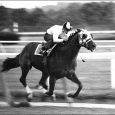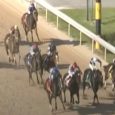Author’s Note: The following is an update of a story I wrote on Jan. 3, 2015.
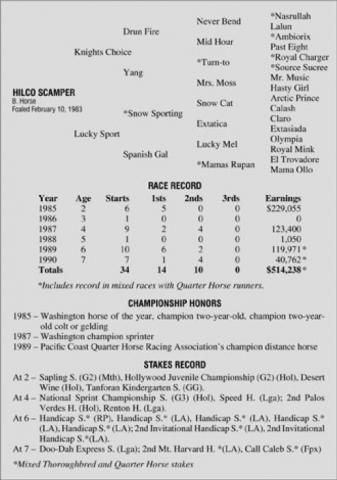 I was at Longacres, the scenic racetrack once located in Renton, Washington, when a horse named Hilco Scamper made his career debut on May 18, 1985.
I was at Longacres, the scenic racetrack once located in Renton, Washington, when a horse named Hilco Scamper made his career debut on May 18, 1985.
Sent off as the 7-5 favorite, the two-year-old gelding made like Secretariat that day, leaving his seven maiden rivals 15 lengths in arrears and traversing five furlongs in :56 4/5 — the fastest time for a juvenile at that distance in the state of Washington… ever.
The son of Knights Choice went on to win the Tanforan Kindergarten Stakes at Golden Gate Fields and the Desert Wine Stakes and Hollywood Juvenile Championship (a Grade II affair) at Hollywood Park. He then shipped east to Monmouth Park, where he annexed his second Grade II event, the Sapling Stakes.
Alas, however, Hilco Scamper’s brush with national glory was as fleeting as he was fast. Just 15 days after his Sapling score, the Washington Racing Hall of Fame inductee bowed a tendon and straggled home seventh as the 4-5 favorite in the Grade I Hopeful Stakes at Saratoga.
Although he would recover and even win the Grade III National Sprint Championship at Hollywood Park as a four-year-old, Hilco Scamper was never the same; he finished his career racing Quarter horses at Los Alamitos and Fairplex Park.
But this isn’t a story about Hilco Scamper — or even a man named Brady. This is a story about the gelding’s trainer, Mike Chambers.
Like the horse he nursed through two bowed tendons, Mike Chambers is a survivor. His career as a trainer began in the mid-1970s and he credits longtime California conditioner Jim Hill with helping him get started.
From 1976 to 1997, Chambers sent 5,328 horses to post — an average of 242 per year — and won with 940 of them (17.6 percent). By the mid-90s, he had hit the big time. He was a familiar face in Southern California racing circles and, in 1997, his stable topped $1 million in earnings for the first time ever — thanks, in large part, to Hesabull, who finished second in the Breeders’ Cup Sprint that year.
Then, like Hilco Scamper those many moons ago, it all came to screeching halt.
Over the next four years, Chambers sent out just 190 runners — less than 48 per year — and made a mere 22 trips to the winner’s circle (11.6 percent). By 2002, he was out of the game altogether.
“My main stable was in Southern California and my main client decided not to buy any more yearlings,” Chambers explained in an ESPN piece written by Bill Finley. “I decided to get rid of the ones I had and went up to Idaho and ranched up there for a few years. We were running cattle up there.”
“Hey, I’m a survivor,” Chambers later told the Seattle Post-Intelligencer. “Mostly, I do whatever it takes, but cattle ranching just wasn’t my bag. My wife and I worked side by side in sub-zero weather for years. Cattle prices went south.
“You want stories? Hell, I got a lot of ’em — frozen engine blocks, frozen pipes, frozen calves in the snow… on and on.”
So, with another career on the brink of implosion, Chambers went back to doing what he does best. Utilizing his California connections, Chambers managed to broker a deal with owner Ron Judy and trainer Eoin Harty of Darley Stables to acquire a number of Sheikh Mohammed bin Rashid al Maktoum’s underperforming stock.
“Yeah, it was quite a deal,” Chambers noted in the Post-Intelligencer. “Ten of those horses sold in Kentucky for more than $10.6 million. When their horses fail to meet classic race expectations, they dump ’em. At that level of the game, a $50,000 horse has no value. Can you believe it? Crazy as it sounds, we got the whole lot for … I can’t tell you the exact price, but it was pennies on the dollar.”
And Chambers started winning again. Actually, he won like never before. From 2005 to 2007, he visited the winner’s circle at an amazing 31.3 percent clip. In 2008, he finished the year — not a single meet, mind you, but the year — with a 37.8 percent winning average. In fact, from 2005 to 2013, Chambers’ lowest year-end winning percentage was better than the highest year-end winning percentage he recorded in his prior 26 years as a trainer.
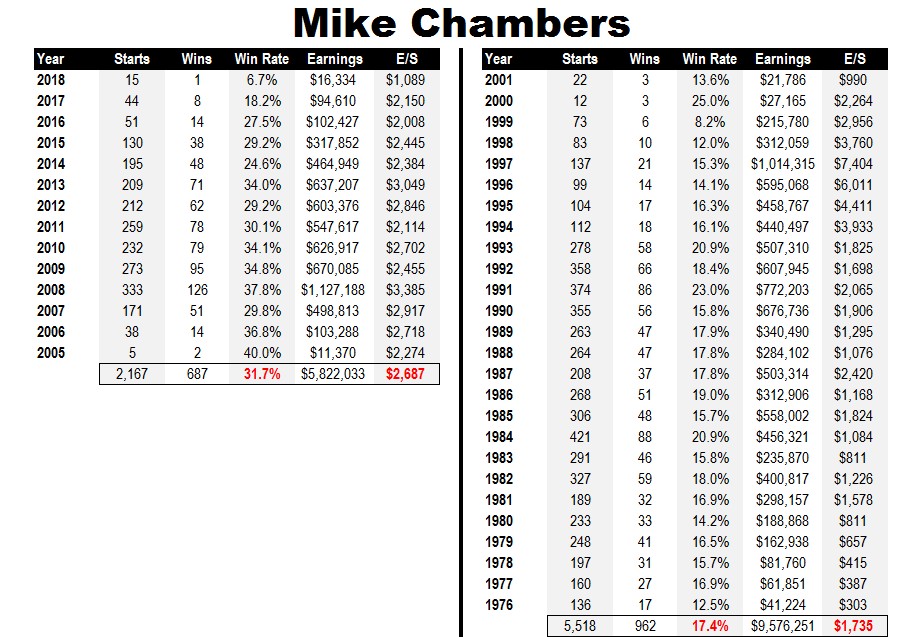
Naturally, when Mario Mendoza suddenly becomes Ted Williams, eyebrows get raised. Frankly, it is hard not to notice that Chambers’ career trajectory is eerily similar to that of the controversial Jamie Ness.
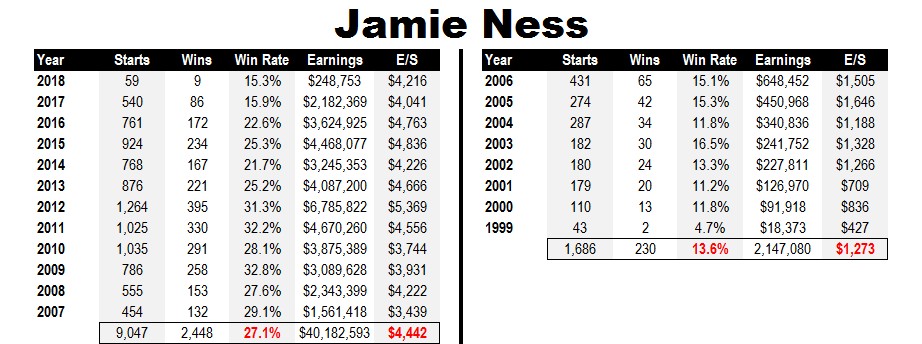
Chambers is not oblivious to the muttering.
“They all think you’re using something. But when you run one for $5,000 that’s worth $20,000, it’s easy to win. They all think that crap. They can think what they want. We keep pounding at them,” Chambers explained to ESPN.
Now, whether Chambers, Ness or any of the other “super trainers” (as Andy Beyer has dubbed them) are guilty of spiking the feed tub is open to debate. What piques my interest is Chambers’ contention that, in essence, he runs his horses for less than they are worth.
Many years ago, I analyzed Todd Pletcher’s record and found that, consistent with what Chambers says, Pletcher had a great winning percentage with horses dropping in class — especially those in good form and, hence, offering no compelling reason for the dip in company.
While it would be naïve to believe that all super trainers are accumulating their gaudy numbers solely by running superior horses against inferior competition, there is little doubt that the two feed on each other — mismatches help to boost one’s winning average and one’s winning average helps to give one the leverage to run horses for less than their worth (who’s going to argue with a trainer winning 38 percent of the time?).
So the next time you see a super trainer dropping a good horse in class, remember Mike Chambers and Hilco Scamper… and rush to the window.

